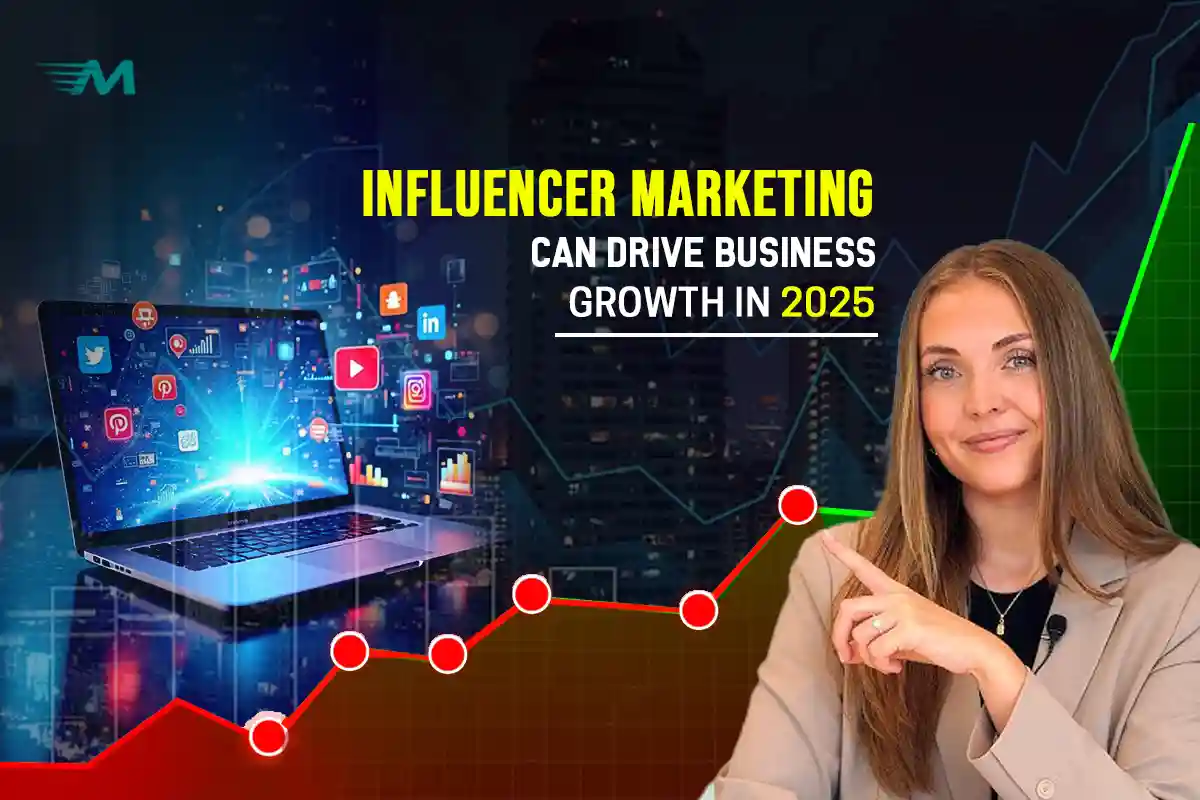How Influencer Marketing Can Drive Business Growth in 2025
Now, companies cannot just rely on advertisements and SEO to get their attention. People today prefer honesty which is why Influencer Marketing for Businesses can do wonders. This type of marketing takes advantage of personal suggestions from people who have a strong following online.
No matter if an influencer mentions something quickly, gives a tutorial or writes a review, people often follow their advice. Relying on this technique, businesses get to target specific customers and build true relationships that standard advertising rarely achieves.
Table of Contents
grasping the main ideas of Influencer Marketing
Partnering with influencers means involving people who can affect the decisions of certain groups of purchasers. On Instagram, YouTube, TikTok, LinkedIn and their personal blogs, these influencers usually have followers who trust them.
Influencer collaborations differ from regular marketing as they are more people-focused and rely on sharing of content, easily fitting into the influencer’s usual social media posts. As a result, an honest bond is built with potential customers and Influencer Marketing for Businesses proves effective for increasing a brand’s visibility, encouraging involvement and more sales.
Selecting the Correct Kind of Influencer
Some influencers do not offer the same worth as others. The success of your marketing campaign is improved by matching influencers’ skills to what your business wants to achieve and who your audience is.
Compared to other social trends, celebrities or other figures with large audiences are very expensive to work with. Those in the 100,000 to 1 million follower range are known as macro-influencers and generally specialize in one niche, striking a balance between their followers and the interaction they have. Because they have a close-knit following, micro-influencers are a great pick for brands aiming to reach a specific group of people.
Finally, nano-influencers tend to have the highest engagement ratios since they often manage very close-knit communities and they can be especially appropriate for running campaigns that focus on specific areas. Seeing the influencer hierarchy allows brands to select collaborations that are most worthwhile.
Setting up the Campaign Objective
- Define clear and specific goals before launching your influencer marketing campaign.
- Common objectives include brand recognition, lead generation, product promotion, website traffic, or social media growth.
- If your primary goal is increasing product sales, choose influencers skilled at persuading their audience to purchase.
- For brand awareness campaigns, focus on influencers who offer high reach and impressions.
- Ensure all objectives are measurable to track the effectiveness of the campaign.
- Measurable goals are essential for managing Influencer Marketing for Businesses in a structured and result-oriented manner.
Discovering the Best People to Partner With
There are many steps involved in choosing the right influencer. Before planning to advertise, businesses should learn who their target audience is and which platforms they use most. The person you choose should genuinely relate to your industry. The material produced on social media ought to reflect your company’s tone, principles and appearance.
Likes, shares, comments and the type of discussions are much better measures than follower count. Having many involved followers is a good sign that individuals trust the brand. You can use Upfluence, BuzzSumo and Heepsy to assist with research and reviewing prospects. If a good match is made, partnering with influencers can enhance the brand’s dependability and add lasting worth.
Supporting Realistic and True Collaboration
Authenticity is the main factor for influencer partnerships to succeed. Influencers should be allowed to show the product in a way that reflects their individuality. Working together too closely, using a script, often comes across as fake for the audience and may even turn brand customers away.
It is better for companies to try to establish lasting relationships that help them advertise their brand more regularly. Involvement with them helps the brand be more noticeable and handy in their work which increases the chance of being remembered and bought. When creating an effective strategy, make sure to let influencers act independently and focus on a positive outcome for all.
Picking the Proper Platform
- Make your decision about the platform based on who you want to reach and what relates to your goals.
- Instagram allows users to share photos and videos which is why it’s chosen by fashion, beauty, travel and food businesses.
- Among all the platforms, YouTube has the best and most detailed product reviews, tutorials and video tutorials.
- In technology, consulting and finance, LinkedIn is the favored portal for working together with B2B influencers.
- On TikTok, young people tend to watch creative and short-length videos.
- Twitter makes it possible to carry out campaigns live and to share messages highlighting thought leadership.
- Even though blogs appear old-fashioned, they can give a strong boost to your SEO and allow you to include detailed product or service reviews.
- Find out where your customers are engaged every day and have influencers spread their activities on those platforms for the best outcome.
Forming the Partnership in A Professional Manner
Carefully defining an agreement is necessary so that problems and confusion are avoided. Be sure to include the work to be done, what the influencer will get, when the task is due, how content is to be formatted, the influencer’s compensation and information on disclaiming such as using hashtags like #ad or #advertisement.
It is important to include details that show whether a brand can use influencer content later on in other campaigns. For a great partnership in Influencer Marketing, both parties should use a professional and clear approach.
Evaluating the success of a Campaign
For an influencer campaign to work effectively, companies use data as their basis. Looking at the engagement rate, how far the content reached, CTR, conversions and sales numbers helps clarify what you got out of the partnership. With Google Analytics and other available data, you can follow how customers go through your funnel.
Cost per acquisition (CPA) and return on advertising spend (ROAS) are essential to learning about profitability. Influencer marketing should not only focus on vanity statistics; if handled properly, it helps achieve real business results.
Caestudies
Case Study 1: SaaS Startup
A B2B SaaS company collaborated with LinkedIn influencers in the tech domain to promote their AI-based analytics tool. They saw:
- 40% increase in qualified leads
- 60% boost in webinar attendance
- High engagement on thought-leadership posts
Case Study 2: D2C Beauty Brand
An Indian beauty startup worked with Instagram micro-influencers to promote a new skincare line. They achieved:
- 3x increase in product page traffic
- 20% spike in new customer acquisition
- Improved brand recall among Gen Z
These examples show that Influencer Marketing for Businesses can be tailored across industries with measurable success.
Steer clear of Standard Mistakes
It is common for businesses to get involved in influencer marketing without proper preparation, so their results aren’t good enough. Many businesses make the mistake of focusing only on the number of followers an influencer has and not on how involved their fans are or who they actually are. When companies manage their brand tightly, the messages may end up being fake and unappealing to customers.
Using promotions that are not transparent with consumers can lessen the faith they have in brands. In addition, companies tend to forget about following their campaign results and have no idea if it worked. You should avoid these errors to guarantee that Influencer Marketing for Businesses keeps being both ethical and effective.
Trends That Are Shaping our Future
Things in influencer marketing are changing very fast. Predictive analytics are being used by some companies to determine influencers that are likely to yield good results. AI technology is very accurate in reviewing a page’s tone, assessing whether followers are genuine and measuring the attitudes of the audience.
There is a new trend of computer-generated influencers gaining large audiences and this is making the difference between real life and online personas less clear. More savvy consumers require companies to promote their goods in a way that is open and ethical. Businesses that focus on long-lasting and value-driven partnerships will retain customers’ trust and interest as things change in the market.
Conclusion
Influencer Marketing for Businesses is now seen by all as a useful and reliable strategy. Either if a company is starting out or has been around for a while, working with trusted influencers lets them effectively reach their chosen audience.
For success, you should focus on good planning, pick the right influencers, define your objectives clearly and develop long-lasting partnerships. If the process continues and companies stick to being genuine, influencer marketing can become extremely valuable for your company.
FAQ
Q: What is influencer marketing in business?
A: It’s the collaboration between businesses and influencers to promote products or services to specific audiences.
Q: Can small businesses use influencer marketing?
A: Yes, micro and nano-influencers are ideal for small businesses with limited budgets.
Q: How do I find the right influencer?
A: Focus on relevance, engagement rate, and audience alignment with your brand.
Q: What platforms are best for influencer marketing?
A: Instagram, YouTube, LinkedIn, and TikTok, depending on your industry and audience.
Q: How is success measured?
A: Through KPIs like reach, engagement, traffic, conversions, and ROI.


